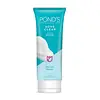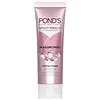What's inside
What's inside
 Key Ingredients
Key Ingredients

 Benefits
Benefits

 Concerns
Concerns

 Ingredients Side-by-side
Ingredients Side-by-side

Myristic Acid
CleansingGlycerin
HumectantWater
Skin ConditioningPropylene Glycol
HumectantPotassium Hydroxide
BufferingStearic Acid
CleansingLauric Acid
CleansingGlycol Distearate
EmollientDecyl Glucoside
CleansingGlyceryl Stearate
EmollientParfum
MaskingTerpineol
MaskingDMDM Hydantoin
PreservativeSalicylic Acid
MaskingThymol
AntimicrobialPolyquaternium-7
Disodium EDTA
Butylene Glycol
HumectantNiacinamide
SmoothingIodopropynyl Butylcarbamate
PreservativeSodium Benzoate
MaskingMyristic Acid, Glycerin, Water, Propylene Glycol, Potassium Hydroxide, Stearic Acid, Lauric Acid, Glycol Distearate, Decyl Glucoside, Glyceryl Stearate, Parfum, Terpineol, DMDM Hydantoin, Salicylic Acid, Thymol, Polyquaternium-7, Disodium EDTA, Butylene Glycol, Niacinamide, Iodopropynyl Butylcarbamate, Sodium Benzoate
Water
Skin ConditioningCyclopentasiloxane
EmollientGlycerin
HumectantCaprylyl Methicone
Skin ConditioningCaprylic/Capric Triglyceride
MaskingDimethicone Crosspolymer
Emulsion StabilisingDimethicone
EmollientPotassium Chloride
PEG-10 Dimethicone
Skin ConditioningSucrose Distearate
EmollientTitanium Dioxide
Cosmetic ColorantAcrylates Crosspolymer
AbsorbentStearyl Dimethicone
EmollientParfum
MaskingStearic Acid
CleansingMagnesium Sulfate
Cholesterol
EmollientDisteardimonium Hectorite
StabilisingDMDM Hydantoin
PreservativeOctadecane
EmollientIsomerized Linoleic Acid
Skin ConditioningAmmonium Lactate
BufferingDisodium EDTA
Acetamide Mea
HumectantRetinyl Palmitate
Skin ConditioningCetyl Alcohol
EmollientButylene Glycol
HumectantHelianthus Annuus Seed Oil
EmollientIodopropynyl Butylcarbamate
PreservativeBHT
AntioxidantCI 17200
Cosmetic ColorantWater, Cyclopentasiloxane, Glycerin, Caprylyl Methicone, Caprylic/Capric Triglyceride, Dimethicone Crosspolymer, Dimethicone, Potassium Chloride, PEG-10 Dimethicone, Sucrose Distearate, Titanium Dioxide, Acrylates Crosspolymer, Stearyl Dimethicone, Parfum, Stearic Acid, Magnesium Sulfate, Cholesterol, Disteardimonium Hectorite, DMDM Hydantoin, Octadecane, Isomerized Linoleic Acid, Ammonium Lactate, Disodium EDTA, Acetamide Mea, Retinyl Palmitate, Cetyl Alcohol, Butylene Glycol, Helianthus Annuus Seed Oil, Iodopropynyl Butylcarbamate, BHT, CI 17200
 Reviews
Reviews

Alternatives
Ingredients Explained
These ingredients are found in both products.
Ingredients higher up in an ingredient list are typically present in a larger amount.
Butylene Glycol (or BG) is used within cosmetic products for a few different reasons:
Overall, Butylene Glycol is a safe and well-rounded ingredient that works well with other ingredients.
Though this ingredient works well with most skin types, some people with sensitive skin may experience a reaction such as allergic rashes, closed comedones, or itchiness.
Learn more about Butylene GlycolDisodium EDTA plays a role in making products more stable by aiding other preservatives.
It is a chelating agent, meaning it neutralizes metal ions that may be found in a product.
Disodium EDTA is a salt of edetic acid and is found to be safe in cosmetic ingredients.
Learn more about Disodium EDTADMDM Hydantoin has antimicrobial and antifungal properties. It is a preservative that works by slowly releasing formaldehyde over time.
So what's formaldehyde?
DMDM Hydantoin is approved for use in cosmetics all around the world.
In the EU, this ingredient is allowed in personal products up to 0.6 percent.
You might have heard of the class-action lawsuit about it causing hair loss. According to chemists, there has not been a link found between this ingredient and hair loss.
The Hydantoin part of this ingredient is created by reacting glycolic acid and urea.
You can check out alternatives to Dmdm Hydantoin:
phenoxyethanol, potassium sorbate, and sodium benzoate.
Glycerin is already naturally found in your skin. It helps moisturize and protect your skin.
A study from 2016 found glycerin to be more effective as a humectant than AHAs and hyaluronic acid.
As a humectant, it helps the skin stay hydrated by pulling moisture to your skin. The low molecular weight of glycerin allows it to pull moisture into the deeper layers of your skin.
Hydrated skin improves your skin barrier; Your skin barrier helps protect against irritants and bacteria.
Glycerin has also been found to have antimicrobial and antiviral properties. Due to these properties, glycerin is often used in wound and burn treatments.
In cosmetics, glycerin is usually derived from plants such as soybean or palm. However, it can also be sourced from animals, such as tallow or animal fat.
This ingredient is organic, colorless, odorless, and non-toxic.
Glycerin is the name for this ingredient in American English. British English uses Glycerol/Glycerine.
Learn more about GlycerinIodopropynyl Butylcarbamate is a preservative.
Parfum is a catch-all term for an ingredient or more that is used to give a scent to products.
Also called "fragrance", this ingredient can be a blend of hundreds of chemicals or plant oils. This means every product with "fragrance" or "parfum" in the ingredients list is a different mixture.
For instance, Habanolide is a proprietary trade name for a specific aroma chemical. When used as a fragrance ingredient in cosmetics, most aroma chemicals fall under the broad labeling category of “FRAGRANCE” or “PARFUM” according to EU and US regulations.
The term 'parfum' or 'fragrance' is not regulated in many countries. In many cases, it is up to the brand to define this term.
For instance, many brands choose to label themselves as "fragrance-free" because they are not using synthetic fragrances. However, their products may still contain ingredients such as essential oils that are considered a fragrance by INCI standards.
One example is Calendula flower extract. Calendula is an essential oil that still imparts a scent or 'fragrance'.
Depending on the blend, the ingredients in the mixture can cause allergies and sensitivities on the skin. Some ingredients that are known EU allergens include linalool and citronellol.
Parfum can also be used to mask or cover an unpleasant scent.
The bottom line is: not all fragrances/parfum/ingredients are created equally. If you are worried about fragrances, we recommend taking a closer look at an ingredient. And of course, we always recommend speaking with a professional.
Learn more about ParfumStearic Acid is a fatty acid. It is an emollient, emulsifier, and texture enhancer.
As an emollient, stearic acid helps soften skin. It aids the skin's protective barrier by preventing water loss. It also provides a gentle cleansing effect without stripping away natural oils.
Stearic acid may also be used to enhance the texture of products. It can add volume and stabilize ingredients such as water and oil. This can help water and oil ingredients from separating.
Sources of stearic acid include animal or vegetable fats/oils such as coconut or shea. It can be naturally found in butter, cocoa butter, shea butter, vegetable fats, and animal tallow.
This ingredient may not be Malassezia folliculitis, or fungal-acne safe.
Learn more about Stearic AcidWater. It's the most common cosmetic ingredient of all. You'll usually see it at the top of ingredient lists, meaning that it makes up the largest part of the product.
So why is it so popular? Water most often acts as a solvent - this means that it helps dissolve other ingredients into the formulation.
You'll also recognize water as that liquid we all need to stay alive. If you see this, drink a glass of water. Stay hydrated!
Learn more about Water